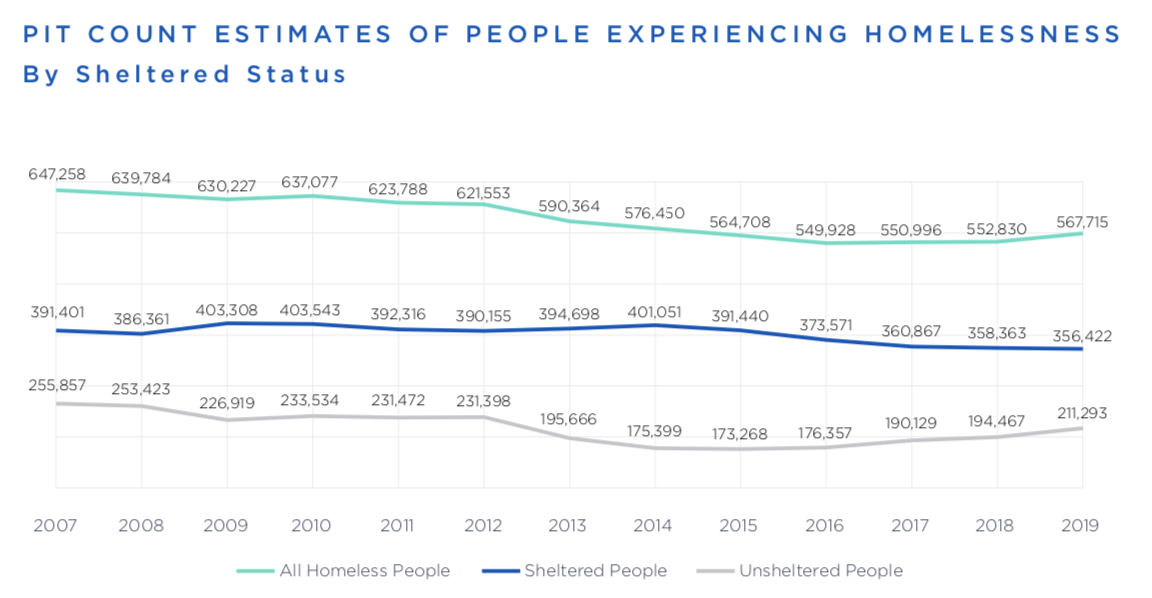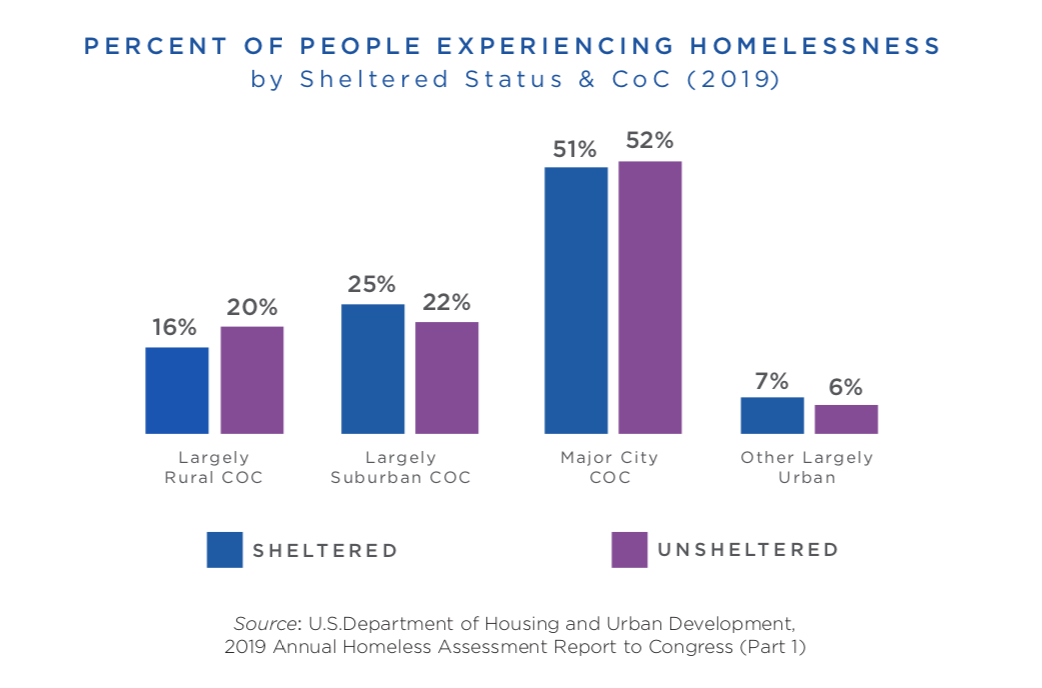For many municipal leaders, January not only marks the beginning of a new year, but also the Point-in-Time Count (PIT Count) — the annual count of people experiencing sheltered and unsheltered homelessness on a single night, facilitated by the U.S. Department of Housing and Urban Development (HUD). The annual PIT Count has and continues to be a sobering reflection of the persistence and prevalence of homelessness in the United States in rural, suburban, and urban areas alike. According to the most recently available data, a total of 567,715 individuals were experiencing homelessness on a single night in January 2019. The 2021 PIT Count, however, has proved to be a more Herculean effort than in years prior, given the impacts of the pandemic.

Source: U.S. Department of Housing and Urban Development,
2019 Annual Homeless Assessment Report to Congress (Part 1).
While for many communities the annual enumeration of people experiencing homelessness will not look the same as it did in years prior, leveraging accurate data remains critical to developing effective interventions and targeting resources.
People experiencing homelessness are far from a monolithic group, with each individual and family facing a unique network of both causes and consequences of homelessness, including housing unaffordability, income stagnation, racial disparities, mental health struggles, substance use challenges and/or domestic violence. Accurate and timely data is essential if cities are to identify proper strategies to tackle the issue and direct adequate resources toward effective policies and programs.
Despite the best efforts of Continuums of Care (CoCs) — a regional planning body that coordinates housing and services for people experiencing homelessness in a defined geographic area — the PIT Count is widely considered to be severe undercount of the homeless population. Some subpopulations are more likely to be undercounted than others, such as youth, who tend to be more mobile, transient, and stay with friends or in groups, so are harder to identify. Additionally, the timing of the annual count during the last 10 days of January means that while more people tend to make use of the shelter network, those who are unsheltered may be harder to spot because they are likely to be seeking refuge from the cold.

Source: U.S. Department of Housing and Urban Development,
2019 Annual Homeless Assessment Report to Congress (Part 1).
The PIT Count During COVID-19
These barriers to an accurate enumeration have been dramatically exacerbated by the COVID-19 pandemic. Understanding the unique barriers that the pandemic presents and the potential health risks, HUD stipulated that COCs can request an exception to some or all of the unsheltered PIT Count requirements. As of early January, 150, or almost 40 percent of CoCs, applied for the exception and will either not conduct the count at all, or will conduct the count but not provide all data elements HUD has required in the past (e.g., demographic, subpopulation, or households characteristics). Some cities, such as Denver, CO, express concerns about the accuracy and longevity of the data they would collect given the rate at which people may be losing their housing and the potential for an undercount more drastic than in years prior.
Despite these critical shortfalls, the PIT Count estimates shed light on notable trends that are central to data-driven policymaking. Particularly as many cities suspect that the pandemic has exacerbated homelessness, a lack of tangible data and evidence may inhibit the ability of municipalities to appropriately target resources and interventions and ultimately, best serve constituents.
What are Cities Doing in light of COVID-19?
Some cities, including Austin, TX and Portland, OR, are forgoing the unsheltered PIT Count completely due to public safety concerns. Others, such as Sacramento, CA, are in conversation about alternative avenues to an accurate count for 2021. This may include designing sampling methods to estimate the number of unsheltered people experiencing homelessness this year based on prior data. The city is also exploring the feasibility of conducting a traditional unsheltered count in 2022, a year in which the unsheltered count would not otherwise be scheduled to take place.
Other municipalities, like Virginia Beach, VA, have chosen to forge ahead with their unsheltered PIT Count, making a few adjustments to the usual methodology. This includes extending their PIT Count over multiple days, and leveraging city volunteers to input visual observations on a publicly available map. Some CoCs, like the Homeless Leadership Coalition of Central Oregon, are extending their Count and relying more heavily on local service providers to survey individuals collecting grab-and-go meals.
Recommendations for Cities
Regardless of whether or not the unsheltered 2021 PIT Count is conducted, data availability and accuracy will not be like years prior due to the pandemic. With the goal of targeted service provision, cities should think about how to make best use of available data and what longer-term changes should be made to collect better data.
Making use of available data
For cities that have received full exception from the unsheltered PIT Count, there remain other strategies for obtaining updated information about the scope of homelessness in a community. This can include examining pre-existing data, such as HMIS data, to estimate the number of unsheltered people experiencing homelessness this year.
Cities that conduct a limited unsheltered PIT Count can leverage data sampling to estimate the number of people experiencing homelessness and even their demographic characteristics based on a partial canvass of the region and by surveying a fraction of the population.
While many changes will have been made to ensure a safe count this year, some changes — such as using a mobile app rather than paper surveys and statistical modeling — may be strategies to employ beyond the pandemic to increase the efficiency and efficacy of the count in the future.
Long-term strategies
Cities should seek to move beyond a once-a-year count, to collecting comprehensive, real-time data year-round. Los Angeles Homeless Services Authority, for example, has launched an online portal that allows community members to report on any homeless individual who needs help, creating a year-round information feedback loop between community members and service providers.
By leveraging technology and community members year-round to bolster data collection efforts, CoCs can achieve targeted service provision and reach specific subpopulations, rather than relying on a once-a-year count that has historically fallen short of offering a comprehensive picture.
Also in California, the Bakersfield Kern Regional Homelessness Collaborative has established a Coordinated Entry System, which allows the CoC to collect data in a centralized location, and use weekly data updates to determine the effectiveness of various strategies used. Kern County credits its success in functionally ending chronic homelessness over the last year, despite the economic and public health impacts of COVID-19, to its robust and frequent data collection process.
By leveraging technology and community members year-round to bolster data collection efforts, CoCs can achieve targeted service provision and reach specific subpopulations, rather than relying on a once-a-year count that has historically fallen short of offering a comprehensive picture.
While much remains in flux this year, it is clear that just as some concessions have been made as to how the count was conducted, other adjustments will be made regarding how the data is analyzed and utilized. While local leaders should be aware that data availability may not be the same as in years prior, this is a critical time for municipalities to also reassess how data is collected and used going forward.
Learn More
Unlocking Homelessness, Part I: Who Experiences Homelessness and Why, a new report from NLC, delves into the information behind the PIT Count data, exploring the root causes and consequences of homelessness to support targeted policymaking. This report is part of the Unlocking Series, which will provide foundational information about housing and community development practices for tenured elected officials and city staff.












